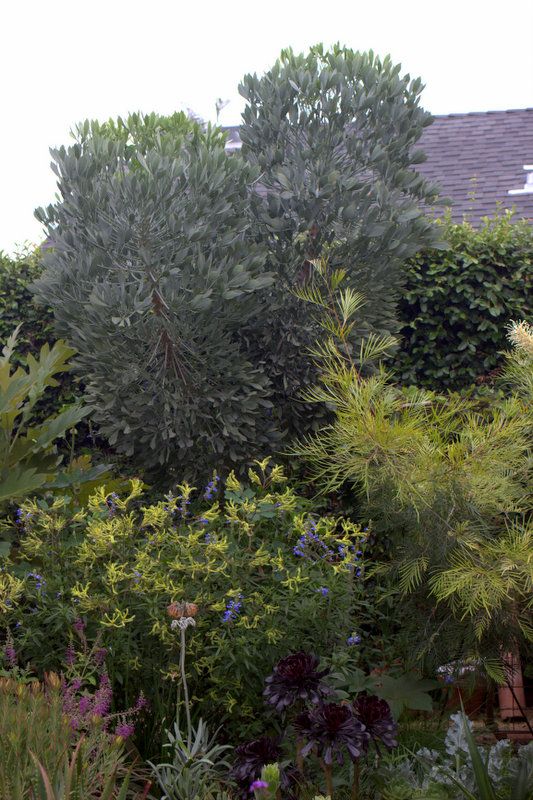
Right up there with rampant vines, another example of one of my current garden anxieties is the sharp northward lean on my Cussonia gamtoosensis. Will it ultimately do a face plant or won’t it? And if it does, will it take tree aloe ‘Hercules'(out of frame) down with it? Now that surrounding summer growth conceals the gravity-yielding trunk, I’ve felt more relaxed; as the old saw goes, out of sight, out of mind. But all winter I fretted over that exposed trunk with its oblique angle and shook it hard whenever I passed, testing the roots’ grip in the soil. Seems solid enough, but who can say? Trees are so inscrutable.
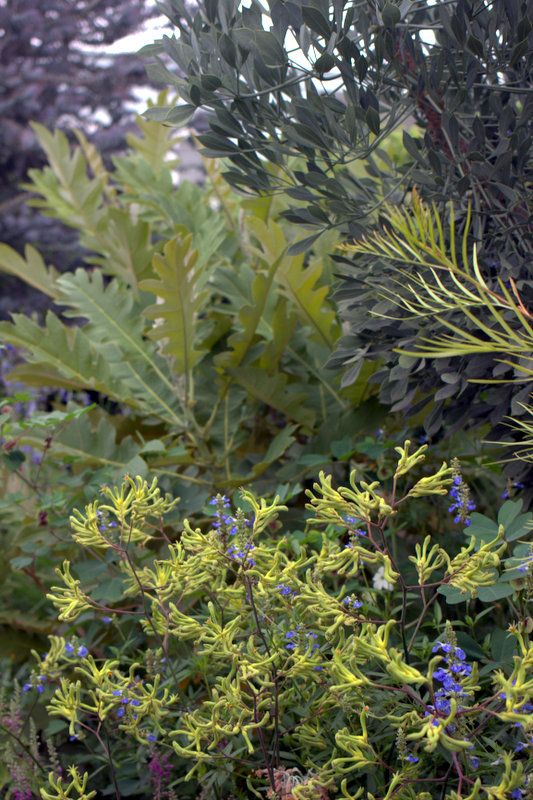
I love how the tall-growing kangaroo paws and bog sage have begun to just graze the bottom of the canopy in June.
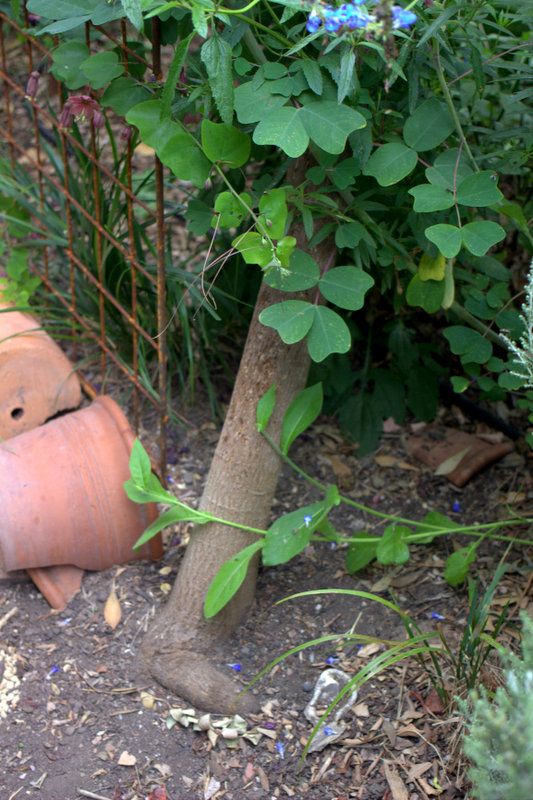
Here’s the trunk (doubling as a cat-scratching post), planted in the same position as the trellis for Passiflora ‘Flying V.’
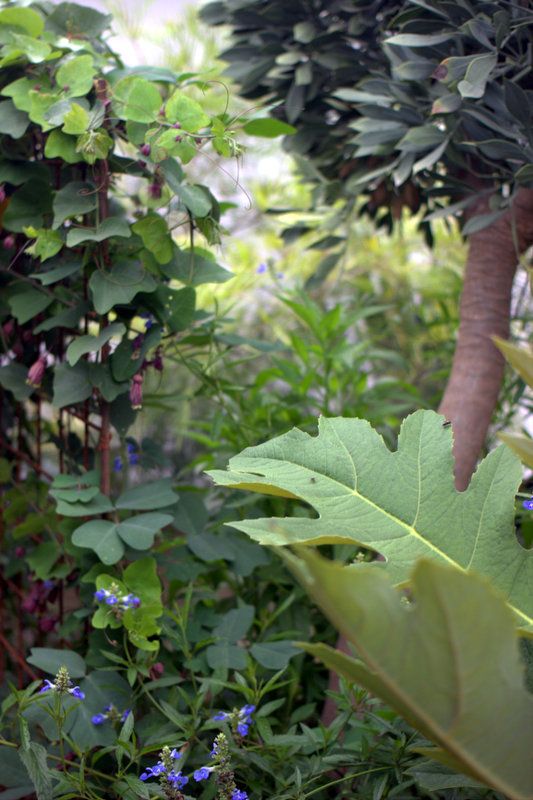
And here’s the gap showing how the tree diverges from an upright orientation, away from the trellis, leaning north.
There’s still not a lot known about this “cabbage tree” from the Eastern Cape Province of South Africa. The lengthiest on-line description comes from this site:
“Usually (but not always) a many-stemmed cabbage tree. The natural distribution of this species, discovered in 1975, is limited to the immediate vicinity of the Gamtoos River. Listed as threatened in the Red Data Book. Preferring well-drained soil and lots of sun, it grows to a height of 2-4m. Semi-drought resistant. Makes a good pot plant. Flowers insipid. Fruit 8mm long, conical, fleshy, purplish, with bracts clasping the fruit, closely crowded along the spikes. Foliage grey-olive.”
(Fancy buying some South African property along the Gamtoos River? Have a look here.)

Looking west, just behind the eryngium, pennisetum, and bocconia, the cussonia now tops the garage roof. The three main branches are visible from this view.

Eryngium pandanifolium skyrocketed blooms this year. This is the first seedling from the original mother plant to bloom. Note how tall and very straight.

What excellent posture — that’s the spirit!
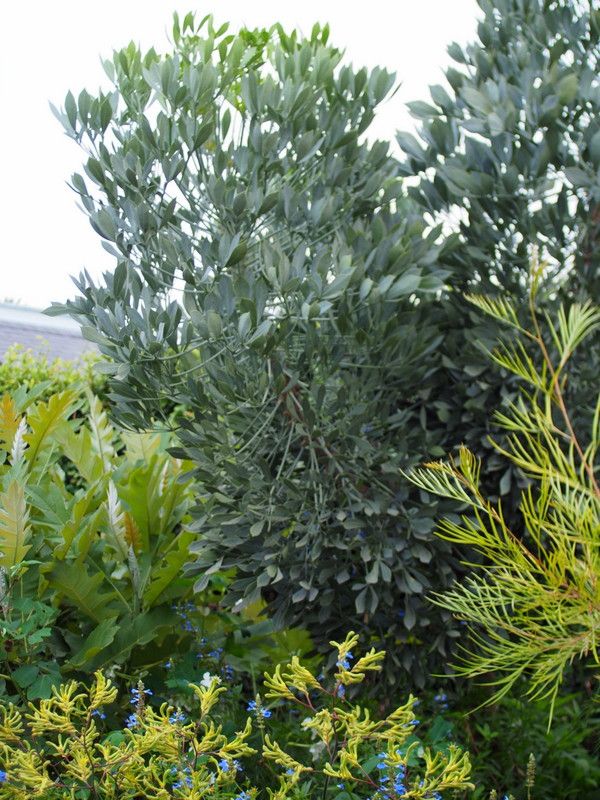
Looking southward, two of the cussonia’s branches appear to be making the shape of a a heart. (Love you back, but just straighten up a bit, will ya?)
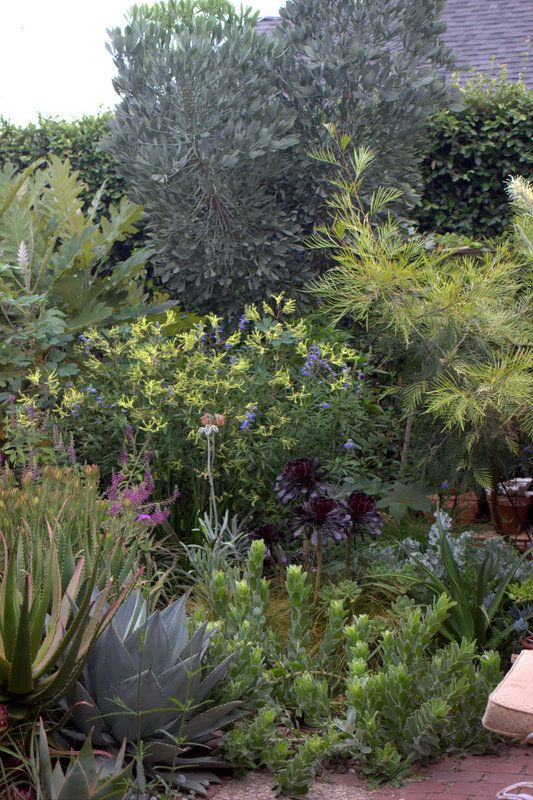
Pressed on either side by bocconia and Grevillea ‘Moonlight.’ I’m told crookedness in cussonias is not uncommon, but it still makes me a little nervous.
I spent a lot of time this 90-degree day in that chair just visible, reading Andrea Wulf’s wonderful biography of Alexander von Humboldt, “The Invention of Nature.” This footnote included from Humboldt’s “Personal Narrative” uncannily describes what I was sensing in the garden this hot, lazy afternoon, an echo and match in mood across centuries:
“[A]mid this apparent silence, when we lend an attentive ear to the most feeble sounds transmitted by the air, we hear a dull vibration, a continual murmur, a hum of insects that fill, if we may use the expression, all the lower strata of the air. Nothing is better fitted to make man feel the extent and power of organic life. Myriads of insects creep upon the soil, and flutter around the plants parched by the ardour of the Sun. A confused noise issues from every bush, from the decayed trunks of trees…There are so many voices proclaiming to us, that all nature breathes; and that, under a thousand different forms, life is diffused throughout the cracked and dusty soil…and in the air that circulates around us.”
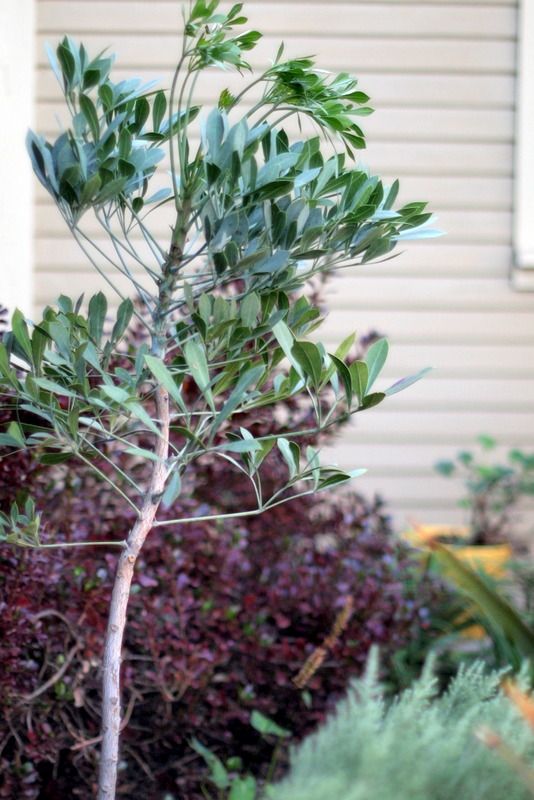
Back to my off-kilter cussonia. It was much easier to photograph as a young tree in December 2013.
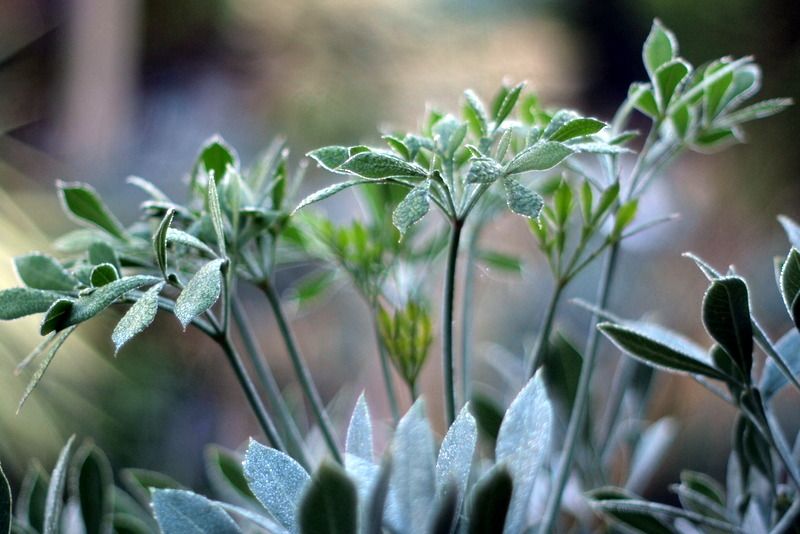
Its leaves just might be my favorite of all my cussonias.
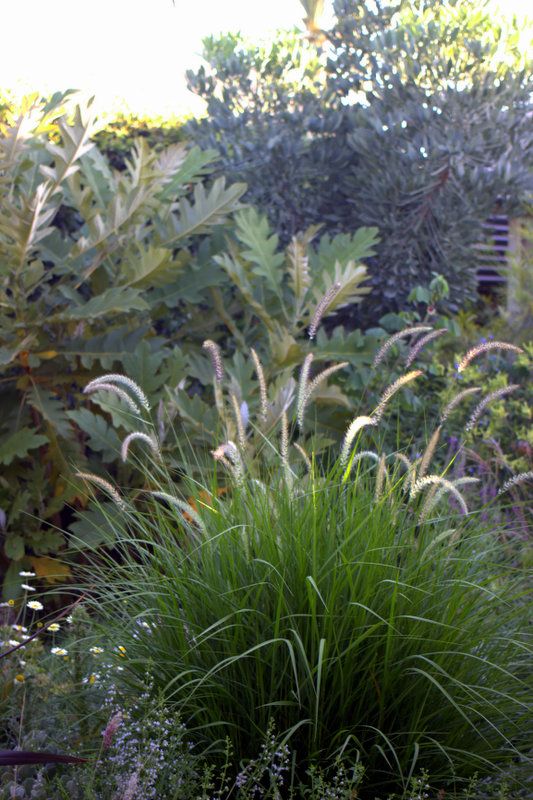
And now that little tree takes its place as a valued, if less than upright, blue-grey backdrop to summer.
With crooked trees on the brain, I enjoyed this recent article in The Los Angeles Times, “The case of the leaning pine tree: A natural history mystery unfolds on the Central Coast.” In this case, it’s a matter of leaning to the south instead of to the north (or, more precisely, toward the equator), and for still mysterious reasons. The tree in question is the Cook pine, named after explorer Capt. James Cook. The article doesn’t mention it, but Joseph Banks was the botanist on Cook’s voyage to New Zealand and Australia, from which Banks brought back to Europe so many plants we love (banksia!) as well as aboriginal words like tattoo. And Joseph Banks happened to be an elder contemporary of my afternoon companion, Alexander von Humboldt.

Time to leave armchair adventures behind and head inside. Stay cool!

The Cook pine!!! Extraordinary story. Like they’re yearning for the equator. Reminded of that Neil Young song – “This old world keeps spinning around, it’s a wonder tall trees aint lying down..” Good luck with your Cussonia too. I have spicata in a pot and it’s very well behaved. Also from that article – the pox that is the eucalypt. Coming from the home of this messy, boring, allelopathic, inflammable (up to 8% volatile oil) genus, I would caution anyone thinking that they represent a benign presence on the landscape. Look what happened in Portugal recently. Some magnificent garden worthy species out there, but on the whole – look away, look away….
Ross, I didn’t know the Portugal fire was in part attributed to eucalypts — omg! I’ve got spicata in a pot too but find its growth habits puzzling. It always drops all the previous year’s leaves and starts new growth out of the growing tip, looking kind of awkward for several months until the leaves mature. I wish I could move it out of the pot and into the garden but there’s not an inch left. And funny you should mention Neil — he’s been getting some play during these long summer evenings outdoors 😉
Beautiful Cussonia. Want! The scene with it and ‘Moonlight’ Grevillea and Leucospermum with new growth and Agave, quite delicious.
I’ve been meaning to read that Humboldt biography. Stay cool, the heat wave is almost over…until the next one.
While I’ve never actually articulated it as such, my rule of thumb regarding cussonias in private gardens* is that if it’s not leaning, it’s not a cussonia. They seem excessively phototropic to me, especially in quasi-mediterranean climates; all of mine reach and crook towards the only patch of full sun my backgardens possess. I’ve never had one uproot itself (nor a heavy limb split off, touch, erm, wood), but they certainly make me nervous. I contemplated, in their younger years, topping a few of my larger, arboreal specimens to encourage branching and a more shrub-like habit (when frost didn’t do its job), but I didn’t have the courage. Have you done this, or just let nature run its course? Are you planning on letting the C gamtoosensis reach its full height?
You mentioned the exposed trunk, which is one of the traits I love in cussonias. They thicken up quickly in the ground and then raise their own canopies, the better to enjoy the bark.
*I’ve also seen this in greenhouse culture
@Hoov, the recent heat wave seems overhyped near the coast. We never got out of the low 90s, never turned on the whole-house fan at night. I think the June gloom near the coast was fighting back hard. Inland is another story. One of my current pipe dreams is to have a plant fair, where I’d bring in cussonias, hard-to-find agaves etc, and that damn ‘Pink Butterflies’ kalanchoe that I get so many requests for!
@Saurs, thank you so much for the reassuring info! I haven’t trimmed it at all, but have contemplated removing one of the branches to lessen the weight of the canopy. I don’t think I will now. Your comments about cussonias’ trunk makes me appreciate spicata a bit more, since it’s all trunk right now, with just the new tuft of leaves. Crazy cool plants!
Thanks so much for the heads-up on the Andrea Wulf book. I enjoyed Brother Gardeners and Founding Gardeners more than just about anything I’ve read in years. A garden club I’m in sponsored an author talk with her (promoting Founding Gardeners), and she’s an excellent speaker, too.
‘Moonlight’ Grevillea and just about anything is gorgeous, but the echoes with those kangaroo paws and the pastel mint-chartreuse of that low succulent….
{rrrgghhh!} <–Homer Simpson jelly donut sound
The Cussonia looks as though it has a good footing – has it reached its mature height yet do you think? I was amused by the “flowers insipid” comment in its description. I also enjoyed the quote from Wulf’s book, which felt almost more like poetry than prose.